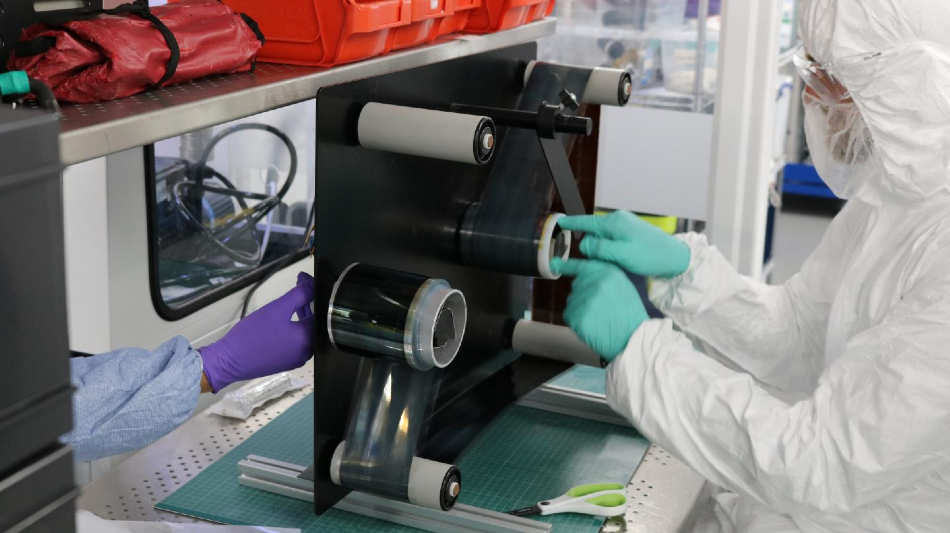Jul 9 2020
According to a new study, roll-to-roll printed perovskite solar cells (PSCs) have achieved the highest efficiency levels to be ever recorded to date.
 Two-step roll-to-roll coating of perovskite thin films at Swansea University, where researchers from the SPECIFIC project have achieved record efficiency levels for printed solar cells. Image Credit: SPECIFIC/Swansea University.
Two-step roll-to-roll coating of perovskite thin films at Swansea University, where researchers from the SPECIFIC project have achieved record efficiency levels for printed solar cells. Image Credit: SPECIFIC/Swansea University.
This record efficiency represents a major milestone and could provide more economical and more efficient methods for producing solar energy.
At the Swansea University’s SPECIFIC Innovation and Knowledge Centre, a research team under the guidance of Professor Trystan Watson has used a roll-to-roll fabrication technique for four layers of slot-die coated with PSCs.
The PSCs provided a steady power output of 12.2%, which is the highest efficiency to be ever recorded for four layers of roll-to-roll printed PSCs, so far.
PSCs are new entrants in the photovoltaic sector and have attracted a great deal of interest from scientists worldwide. Since the efficiency levels of the PSCs are analogous to those of silicon photovoltaics (PV)—the present market leader—attention has been shifted toward upscaling the former.
When compared to the silicon PV, which needs high-vacuum and high-temperature depositions, the PSCs can be solution-processed at low temperatures, which considerably decreases the production cost.
Thanks to low-temperature processing, plastic substrates can be used for making flexible solar cells.
The capacity to solution-process offers the chance to use numerous well-developed coating and printing methods:
- Gravure printing
- Screen printing
- Inkjet printing
- Spray coating
- Slot-die coating
For Swansea University scientists, these benefits allowed them to utilize roll-to-roll manufacturing for four PSC layers.
Many benefits are offered by slot-die coating when compared to the alternatives. For example, slot-die coating is a pre-metered method, meaning that the thickness of the wet film can be controlled prior to coating. This method is also highly efficient in material usage, which means there is minimum material loss when compared to screen printing or spray coating.
Employing the required toxic solvents at a large scale needs plenty of air handling to remain within the safety limits, which can lead to unnecessary and considerable expenses. Therefore, an acetonitrile-based system was used instead. Due to low surface tension and low viscosity, the system has a rheological benefit and results in more improved coatings.
Together with this, a ternary blend of high workplace exposure limit solvents was also employed, substituting chlorobenzene to deposit the hole transport material.
In this study, the PSCs provided a stable power output of 12.2%, which is a record efficiency level to be ever reported for four layers of roll-to-roll printed PSCs.
An entire solar cell for a selected architecture needs five layers of coating. But in this case, four layers were coated through the slot-die coating technique and the top contact was formed using thermal evaporation. Coating the fifth (top) contact through slot-die coating without damaging any underneath layers has not been realized yet. If this problem is solved, a fully roll-to-roll printed PSC could be manufactured.
Perovskite solar cells aim to increase the efficiency and lower the cost of traditional solar energy generation. They have the potential to be highly efficient and relatively cheap to manufacture, so the aim is to improve fabrication methods for upscaling. This study signifies the next step towards commercialization.
Rahul Patidar, Lead Researcher, SPECIFIC Innovation and Knowledge Centre, Swansea University
The study was published in the Sustainable Energy and Fuels journal.